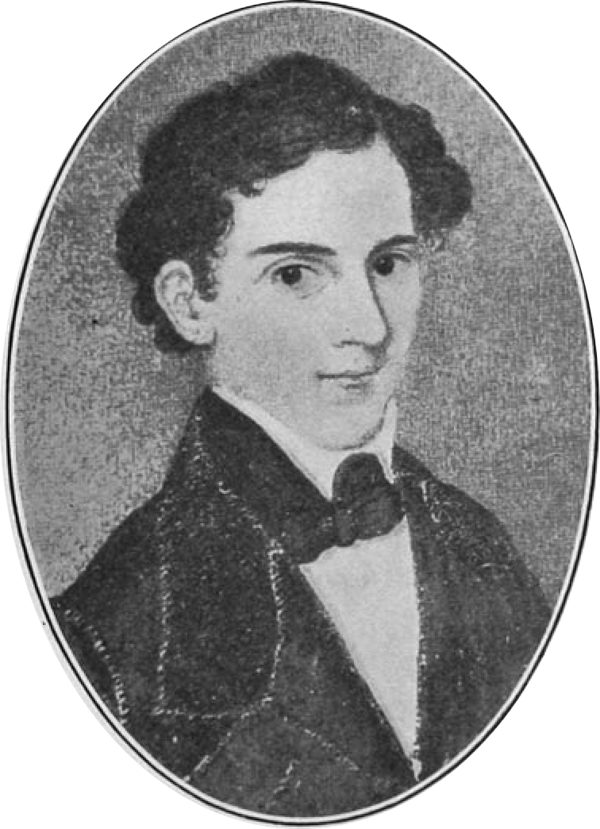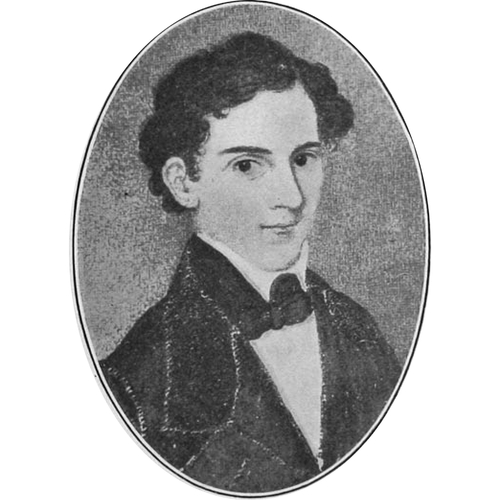
Source: Link
PAINCHAUD, JOSEPH (baptized Joseph-Louis), doctor, surgeon, and philanthropist; b. 12 June 1819 at Quebec, son of Joseph Painchaud*, a doctor, and Marie-Geneviève Parant, and nephew of Alexis Painchaud; d. probably 7 April 1855, in all likelihood near Tonila, Mexico.
Joseph Painchaud grew up in his father’s spacious residence at the corner of Rue des Pauvres and Ruelle de l’Arsenal in Quebec. Third in a family of seven children, he suffered from delicate health and required attentive care from his mother, but he was brought up no less strictly than his brothers and sisters. His father was in comfortable circumstances, thanks to his medical practice, and had been able to protect his family from material worries. A fall down some school stairs had left the young Painchaud half-crippled and made it extremely difficult for him to walk. This handicap did not, however, deter him from beginning classical studies as a day-boy at the Petit Séminaire de Québec in 1835, and he completed them in 1840. During his fourth year (Versification) he felt himself called to be a missionary. At the end of his schooling he wanted to enter the priesthood but his infirmity prevented him from doing so. Accordingly, he studied medicine under his father and Dr James Douglas*, and then went to Paris to finish his training. On 28 Nov. 1846, having returned to Quebec, he received his licence as a doctor and surgeon. Shortly afterwards he entered the Marine and Emigrant Hospital, probably as an intern, under the direction of Dr Douglas. He received no remuneration at that time. In September 1847 he became a resident physician and was granted an annual salary of £100. He remained at this hospital until the spring of 1848.
Unlike his father, Painchaud distinguished himself through neither medical practice nor public activity, but through the considerable though unobtrusive role he played in establishing the earliest conferences of the Society of St Vincent de Paul in Quebec. He had taken advantage of his stay in the French capital in 1845 to form numerous ties with that Catholic association. As well as joining various confraternities and visiting monasteries, he became a member of the society, which had been founded in 1833 by Antoine-Frédéric Ozanam and his friends. He had participated in the meetings and activities of the Saint-Séverin conference. Tradition has it that when he returned to his native city in 1846 he introduced the organization to Quebec, but in fact it had been established there two years before, although with aims and methods modelled only broadly on the Paris society. Apparently a circular letter of 16 June 1846 from the president general of the latter, Jules Gossin, prompted Archbishop Joseph Signay* to try to regularize the status of the Quebec conference. A meeting of 12 Nov. 1846, chaired by Charles-François Baillargeon*, who was then the parish priest of the cathedral, did not therefore constitute the beginning of the new society but rather a fresh start. At the next meeting, on 19 November, Jean Chabot, a member of the House of Assembly who had previously presided over the conference, was elected president. It was not until the meeting of 26 November that the names of the two Painchauds, father and son, were mentioned for the first time in the society’s minutes. The younger Painchaud worked to such good purpose that by 7 March 1847 Quebec had a total of nine conferences, all due to his indefatigable efforts. He even set one up at the Marine and Emigrant Hospital, dedicated to St Abysius Gonzaga. The Quebec conference formed in 1846 was granted affiliation with the Paris society in August 1847, as subsequently, in October, were the eight new conferences and the particular council of Quebec (a body encompassing the various conferences). Here, as would later be stressed, was indeed the “first link joining Old and New France since the separation of 1760.”
Painchaud, who was quite familiar with the practices of the society in Paris, became both the guiding spirit and the driving force of the new organization at Quebec. None the less, following Ozanam’s example, he did not hold any important office in it. Painchaud succeeded in bringing to Quebec the spirit of zeal and piety prevailing in Paris, but it cannot be said that he was imbued with the same social concerns as Ozanam. To Painchaud, material destitution was not an issue of social justice but an opportunity to do good and acquire spiritual merit. The society’s objective was to aid those in greatest need and to succour the unfortunate. Visits to the poor in their homes and the education of needy children were meant not only to provide material relief but to bring spiritual consolation and stir the recipients “to the depths of their souls.”
These endeavours did not exhaust Painchaud’s zeal. In 1845, when he was living in Paris, he had taken a vow to devote himself to missionary work should the day ever come when he could walk without difficulty. Four years later, as his condition had considerably improved, he offered his services as a doctor and catechist to Modeste Demers*, the bishop of Vancouver Island, making over to him his fortune and his estate. On 9 Sept. 1849 he set sail for Paris, where he stayed until the end of 1851, helping the bishop in his attempts to obtain assistance and introducing him into the society he had become acquainted with during his first stay in the city.
The rest of Painchaud’s wanderings were marked by a series of misadventures. Having set out from Le Havre towards the end of 1851, he left New York for San Francisco the next spring aboard an immigrant ship on which he served as doctor. Following a mutiny, the vessel had to call at Rio de Janeiro, where the doctor and his companion, Abbé Laroche, decided to turn back and try to complete the journey by going through Nicaragua. Laroche died of exhaustion while crossing the isthmus. Painchaud embarked once more to go up the Pacific coast but was shipwrecked on the shores of Mexico. Unable to continue the voyage, he made his way to Colima, Mexico, where he erected a hospital and built up a highly lucrative practice. He wrote to Bishop Demers in 1852: “Divine Providence has probably put me here, in order to come more promptly to the assistance of the mission, for I am making money here, [and] I await your Excellency’s orders.” He then went to Tamazula, in the present state of Jalisco, to work a silver mine into which he sank all his new-found wealth. Shortly afterwards he fell ill and is believed to have died somewhere near Tonila and to have been buried there on 7 April 1855.
Joseph Painchaud has remained an unknown figure despite the role he played in establishing the Society of St Vincent de Paul in Quebec. Behind the clichés used by a pious press – “[a] heroic Christian, obedient child, model pupil, worthy and reserved student” – was hidden a tormented spirit inspired by an extraordinary, and at times excessive, religious zeal, but haunted above all by the thought of salvation. His devotion to Our Lady of La Salette, his participation in numerous confraternities, his activity within the Society of St Vincent de Paul, and his missionary vocation were all directed towards one end, to acquire as much merit as possible in this life in order to ensure his eternal salvation. In 1850 he had observed: “I am not much in favour of prayer and good works after one’s death, [for] it is a bad system; it is better to deserve grace during life, for it is too late after one is dead. Doing good on earth means that much more merit in the eyes of God.” His correspondence reflects a religious nature and reveals a personality which are symptomatic of the ideological evolution of French Canadian society around 1850. Father and son – the reform candidate in the elections of 1836 and the lay missionary, the founder of the Quebec Medical Society and the apostle of the Society of St Vincent de Paul – represent not only two generations, but two succeeding and sometimes conflicting visions of the world.
ANQ-Q, CE1-1, 5 juin 1815, 13 juin 1819; P-437. Private arch., Louis Painchaud (Quebec), Corr. of Joseph Painchaud, 1849–51. Le Canadien, 12 janv. 1859. P.-G. Roy, Fils de Québec, 4: 32–33. C.-J. Magnan, Le docteur Joseph Painchaud, fondateur de la Société de Saint-Vincent de Paul au Canada, 1819–1919 (Montréal, 1919). Robert Rumilly, La plus riche aumône: histoire de la Société de Saint-Vincent-de-Paul au Canada (Montréal, 1946). [Henri Têtu], Les noces d’or de la Société de Saint-Vincent de Paul à Québec, 1846–1896 (Québec, 1897). [Thomas Tremblay], La Société de Saint-Vincent-de-Paul: son but, son esprit et ses avantages spirituels (Québec, 1943). Sylvio Leblond, “Le Dr Jos. Painchaud et sa famille,” SCHÉC Rapport, 23 (1955–56): 53–59. C.-J. Magnan, “La fondation de la première conférence de Saint-Vincent de Paul à Québec,” BRH, 32 (1926): 699–702. Arthur Maheux, “L’Ozanam du Canada: Joseph Painchaud,” Rev. de l’univ. Laval, 9 (1955): 735. “Petite galerie historique canadienne, le Dr. Jos. Painchaud,” L’Action catholique (Québec), 19 sept. 1948: 2.
Cite This Article
Louis Painchaud, “PAINCHAUD, JOSEPH (baptized Joseph-Louis) (b. 1819, d. probably in 1855),” in Dictionary of Canadian Biography, vol. 8, University of Toronto/Université Laval, 2003–, accessed January 1, 2026, https://www.biographi.ca/en/bio/painchaud_joseph_1819_1855_8E.html.
The citation above shows the format for footnotes and endnotes according to the Chicago manual of style (16th edition). Information to be used in other citation formats:
| Permalink: | https://www.biographi.ca/en/bio/painchaud_joseph_1819_1855_8E.html |
| Author of Article: | Louis Painchaud |
| Title of Article: | PAINCHAUD, JOSEPH (baptized Joseph-Louis) (b. 1819, d. probably in 1855) |
| Publication Name: | Dictionary of Canadian Biography, vol. 8 |
| Publisher: | University of Toronto/Université Laval |
| Year of publication: | 1985 |
| Year of revision: | 1985 |
| Access Date: | January 1, 2026 |



